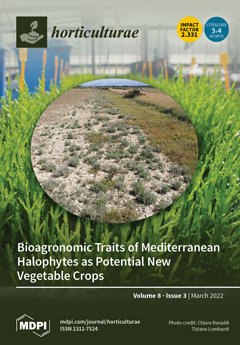This study investigates and quantifies the integrative effects of CO
2 concentration (500, 1000 and 1500 µmol mol
−1), illumination intensity (100, 200 and 300 μmol m
−2 s
−1) and air speed (0.25, 0.50 and 0.75 m s
−1)
[...] Read more.
This study investigates and quantifies the integrative effects of CO
2 concentration (500, 1000 and 1500 µmol mol
−1), illumination intensity (100, 200 and 300 μmol m
−2 s
−1) and air speed (0.25, 0.50 and 0.75 m s
−1) on the growth, gas exchange and light use efficiency of lettuce plants (
Lactuca sativa L.) grown under artificial lighting. The results show that lettuce growth and gas exchange are closely related to CO
2 concentration and illumination intensity, while air speed enhances CO
2 transport during photosynthesis. The most influential two-way interactions were observed between CO
2 concentration and illumination intensity on the fresh and dry weights of lettuce shoots with effect sizes of 34% and 32%, respectively, and on the photosynthesis, transpiration and light use efficiency, with effect sizes of 52%, 47% and 41%, respectively. The most significant three-way interaction was observed for the photosynthetic rate, with an effect size of 51%. In general, the fresh and dry weights of lettuce plants increased by 36.2% and 20.1%, respectively, with an increase in CO
2 concentration from 500 to 1500 µmol mol
−1 and by 48.9% and 58.6%, respectively, with an increase in illumination intensity from 100 to 300 μmol m
−2 s
−1. The photosynthetic rate was found to be positively correlated with CO
2 concentration, illumination intensity and air speed. The transpiration rate and stomatal conductance increased by 34.9% and 42.1%, respectively, when the illumination intensity increased from 100 to 300 μmol m
−2 s
−1. However, as CO
2 concentration increased from 500 to 1500 μmol mol
−1 and air speed increased from 0.25 to 0.75 m s
−1, the transpiration rate decreased by 17.5% and 12.8%, respectively. With the quantified data obtained, we were able to adequately determine how CO
2 concentration, illumination intensity and air speed interact with their combined effects on the growth of lettuce plants grown in indoor cultivation systems with artificial lighting.
Full article





